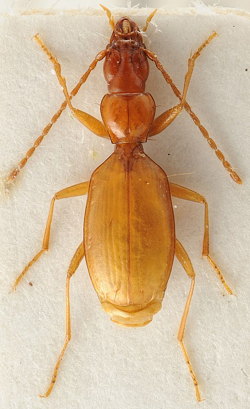Science
Musical Tones of Waterfalls
The "A. Heim" referred to below was the Swiss geographer Albert Heim. (Perhaps the E. Heim was his brother?) His studies of the musical tones of waterfalls led him to formulate the hypothesis that Beethoven wrote the sound of a waterfall into his "Pastoral" symphony. Details from wqxr.org:You can read Heim's article about the musical tones of waterfalls here (but it's in German).

Scribner's Monthly - Apr 1875
Posted By: Alex - Sat Sep 30, 2023 -
Comments (1)
Category: Music, Science, Nineteenth Century
Misdirected amplexus
"Misdirected amplexus" is the scientific term for the curious phenomenon of male frogs attempting to mate with inappropriate objects. Details from the New ScientistFrog mating is often hard to miss. In most species it involves a process called amplexus, in which males grip onto a female tightly for hours or days at a time until the eggs are fertilised. But there are plenty of records of male frogs grappling an unpromising target such as a frog from a different species or a dead individual. One explanation is that such mistakes are more likely to happen in species that breed in large numbers with a low ratio of females to males, and where multiple species occupy the same breeding pond.
I briefly discussed the subject of misdirected mating in the animal kingdom in my book Elephants on Acid. Here's the relevant text:
During the early 1950s, researchers at Walter Reed Army Medical Center surgically damaged the amygdala (a region of the brain) in a number of male cats. These cats became "hypersexual," attempting to mate with a dog, a female rhesus monkey, and an old hen. Four of these hypersexual cats, placed together, promptly mounted one another.
Posted By: Alex - Tue Sep 26, 2023 -
Comments (0)
Category: Animals, Nature, Science, Sex
Hitler Species
There are two species of insects named after Hitler. The mystery, however, might be why more creatures weren't named after Hitler by German scientists during the 1930s, as a way to curry favor with him. The answer, surprisingly, seems to be that requests were made, but Hitler would always ask for his name not to be used. (The insect researchers never asked for his permission). Text from The Art of Naming by Michael Ohl (2018 translation):To date, Anophthalmus hitleri has been found in but a handful of caves in Slovenia. Particularly after the media discovered and circulated the Hitler beetle story in 2000, interest in this species has been rekindled. A well-preserved specimen of Anophthalmus hitleri can fetch upward of 2,000 euros on the collectors' market; among the bidders, certainly some wish to add the Hitler beetle to their collection of Nazi memorabilia. . .
At least one other species has been named after Adolf Hitler: the fossil Roechlingia hitleri, which belongs to the Palaeodictyoptera, a group of primitive fossil insects. Roechlingia hitleri was described in 1934 by German geologist and paleontologist Paul Guthörl. . .
Extensive research has failed to turn up any other species named in honor of Hitler. This seems surprising, as this form of salute could have proven quite expedient to aspiring German scientists from about 1933 until 1945, at the latest...
The likeliest explanation is that when Hitler patronyms were planned, approval was sought in advance from the Führer (by way of the Reich Chancellery), whether out of respect or perhaps fear of potential consequences. In 1933, for instance, a rose breeder submitted a written request to the Reich Chancellery for permission to introduce to the international market one of his best rose varieties, bearing Hitler's name. Similarly, a nursery owner from Schleswig-Holstein hoped to name a "prized strawberry variety" the "Hitler strawberry," in honor of the Reich Chancellor. They already had a "Hindenburg" strawberry variety in their catalog, he added. In reply to both cases, Hans Heinrich Lammers, Chief of the Reich Chancellery, sent almost identical letters, in which the inquiring parties were informed that, "upon careful consideration, [the reich Chancellor] requests that a name in his honor most kindly not be used." . . .
Perhaps this fundamental rejection of honorary names is the reason that so few hitleris exist.

Anophthalmus hitleri
source: Wikipedia
Posted By: Alex - Fri Sep 01, 2023 -
Comments (1)
Category: Dictators, Tyrants and Other Harsh Rulers, Insects and Spiders, Odd Names, Science
Hot Testicle Hypothesis
Elephants rarely get cancer. This seems odd because one would think that, elephants being larger than us and thus having more cells, they should be more prone to cancer than we are, not less.Oxford professor Fritz Vollrath has proposed the "Hot Testicle Hypothesis" to explain this mystery.
The gist of the hypothesis is that elephants have unusually hot testicles for a mammal. Their hot testicles result in more mutations in their sperm. So the elephants have evolved more mutation-suppressing mechanisms in their cells. In particular, they have more copies of "p53 encoding genes" than we do, and these genes play a role in repairing damaged DNA.
More info: technologynetworks.com
Posted By: Alex - Sun Aug 27, 2023 -
Comments (1)
Category: Animals, Science
Corn Rocks
"Corn rocks" are pieces of lava rock that have impressions of pieces of corn imbedded in them. Geologists have found many samples of corn rocks around the Sunset Crater Volcano in northern Arizona. When the volcano erupted, about 1000 years ago, the people that lived around it were evidently putting pieces of corn in the lava to create these rocks. Why they did this is anyone's guess. Perhaps for religious reasons, or perhaps just for fun.
Source: Google Arts & Culture
Geologists tried to create corn rocks of their own at Kilauea Volcano in Hawaii, but they found it wasn't as straightforward as they had assumed. Putting the corn in the path of a lava flow didn't work. Nor did dropping corn on top of a flow. Geologist Wendell Duffield tells the rest of the story:
Obviously, it would not be safe for humans to carry ears of corn into the fallout zone of a towering lava fountain. A safe setting, however, would be at what geologists call an hornito (means "little oven" in Spanish). An hornito is essentially a miniature volcano that spews molten blobs of melt that fall back to Earth and accumulate into a welded-together chimney-like stack as they solidify and cool...
So, early Native Americans living near the present site of Sunset Crater Volcano witnessed an eruption that at some stage could be safely approached to place ears of corn at the base of an active hornito.
Posted By: Alex - Fri Aug 11, 2023 -
Comments (0)
Category: Nature, Science, Anthropology, Ancient Times, Arizona
Ghost Driver Study
Researchers at the University of Nottingham disguised drivers as car seats ("ghost drivers") to study how pedestrians interacted with driverless cars. In particular, they wanted to know what visual cues people would look for when deciding if it was safe to cross the road in front of a driverless car.I haven't yet seen a driverless car on the road, but when I do I'll now be wondering if it actually has a ghost driver behind the wheel.

Posted By: Alex - Sat Jun 17, 2023 -
Comments (2)
Category: Science, Cars
Musical Composition based on Prime Numbers
Let us know how you enjoy it!An essay on the piece here.
Posted By: Paul - Mon Jun 05, 2023 -
Comments (1)
Category: Music, Science, Twenty-first Century, Cacophony, Dissonance, White Noise and Other Sonic Assaults
The Tumpline Hypothesis
The great houses of Chaco Canyon (New Mexico) were built around 1000 years ago, using the wood of over 200,000 trees. However, the trees were about 70 miles away from the houses. So how did the Chacoans get the wood to the construction site? There's no archaeological evidence the wood was dragged, and the Chacoans had no draft animals or wheels.According to the Tumpline Hypothesis, the Chacoans used tumplines, which are straps that go over the head and can be used to carry heavy weights. From Ars Technica:
Posted By: Alex - Tue Apr 25, 2023 -
Comments (1)
Category: Science, Anthropology, Experiments
A comparison of teflon and plastic
From the Hagley Archive's collection of DuPont Product information photographs.Definite industrial chemist as dominatrix vibe.

An explanation:
A photo of another chemist doing the same thing, but it doesn't have the same vibe to it:

Posted By: Alex - Sun Mar 26, 2023 -
Comments (3)
Category: Mad Scientists, Evil Geniuses, Insane Villains, Photography and Photographers, Science, 1940s
The Family That Walks On All Fours
Full article here.
Posted By: Paul - Fri Mar 03, 2023 -
Comments (0)
Category: Human Marvels, Medicine, Regionalism, Science

| Who We Are |
|---|
| Alex Boese Alex is the creator and curator of the Museum of Hoaxes. He's also the author of various weird, non-fiction, science-themed books such as Elephants on Acid and Psychedelic Apes. Paul Di Filippo Paul has been paid to put weird ideas into fictional form for over thirty years, in his career as a noted science fiction writer. He has recently begun blogging on many curious topics with three fellow writers at The Inferior 4+1. Contact Us |




